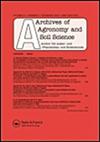细菌衍生的生物聚合物通过介导生理学和根际微生物缓解姜黄(Curcuma longa L.)的营养胁迫并提高产量
IF 1.8
4区 农林科学
Q1 AGRONOMY
引用次数: 0
摘要
生物聚合物(BP)是一种未开发的生态友好型微生物衍生物,可调节土壤水分和养分流动。因此,本研究在2017-18和2018-19年进行了为期两年的田间试验,以确定BP对姜黄降低营养胁迫和提高产量的有益效果。该研究采用了分图设计,每分四种营养水平(对照、50%、75%和100%推荐营养剂量;RDN)和BP(0、2.5、5.0和7.5 kg ha-1)。结果表明,施用BP (7.5 kg ha-1)显著提高了土壤含水量(40.31%)和微生物定植(总微生物、固氮剂和增磷剂)。结果表明,75%和100% RDN配施BP能提高姜黄的光合作用(22.95 ~ 24.50 μmol m−2 s−1),降低姜黄的冠层温度(24.47 ~ 24.67℃)。因此,获得了更高的产量(7.05-7.82 t ha - 1)和部分要素生产率。与单独添加100% RDN相比,BP中添加100% RDN可使姜黄产量提高29-49%。因此,在半干旱的热带营养贫乏的土壤中,即使养分减少25-50%,生物聚合物也能保持相当于100% RDN的姜黄产量。本文章由计算机程序翻译,如有差异,请以英文原文为准。
Bacterial derived biopolymer to alleviate nutrient stress and yield enhancement in turmeric (Curcuma longa L.) by mediating physiology and rhizosphere microbes on poor soils of semi-arid tropics
ABSTRACT Biopolymers (BP) are the unexploited eco–friendly microbial derivatives which regulate soil moisture and nutrient mobility. Therefore, a field experiment was conducted for two years (2017–18 and 2018–19) to determine the beneficial effects of BP in reducing nutrient stress and yield enhancement in turmeric. The study was laid out in a split-plot design with each of four levels of nutrients (control, 50%, 75%, and 100% of Recommended Dose of Nutrients; RDN) and BP (0, 2.5, 5.0, and 7.5 kg ha–1). Results indicated that BP application (7.5 kg ha–1) significantly improved the soil moisture content (40.31%) and microbial colonization (total microbes, N fixers, and P solubilizers). As a result, combined application BP with either 75% or 100% of RDN enhanced the photosynthesis (22.95–24.50 μmol m−2 s−1) and lowered the canopy temperature (24.47–24.67°C) of turmeric. Thus, higher yield (7.05–7.82 t ha−1) and partial factor productivity were achieved. Supplementing BP with 100% RDN enhances the turmeric yield by up to 29–49% over 100% RDN alone. Therefore, biopolymer maintains the equivalent turmeric yield of 100% RDN even at 25–50% less nutrients in the nutrient-poor soils of semi-arid Tropics.
求助全文
通过发布文献求助,成功后即可免费获取论文全文。
去求助
来源期刊

Archives of Agronomy and Soil Science
AGRONOMY-SOIL SCIENCE
CiteScore
5.50
自引率
4.20%
发文量
107
期刊介绍:
rchives of Agronomy and Soil Science is a well-established journal that has been in publication for over fifty years. The Journal publishes papers over the entire range of agronomy and soil science. Manuscripts involved in developing and testing hypotheses to understand casual relationships in the following areas:
plant nutrition
fertilizers
manure
soil tillage
soil biotechnology and ecophysiology
amelioration
irrigation and drainage
plant production on arable and grass land
agroclimatology
landscape formation and environmental management in rural regions
management of natural and created wetland ecosystems
bio-geochemical processes
soil-plant-microbe interactions and rhizosphere processes
soil morphology, classification, monitoring, heterogeneity and scales
reuse of waste waters and biosolids of agri-industrial origin in soil are especially encouraged.
As well as original contributions, the Journal also publishes current reviews.
 求助内容:
求助内容: 应助结果提醒方式:
应助结果提醒方式:


